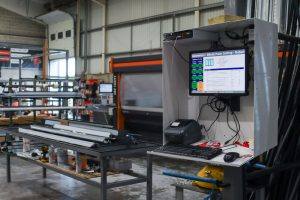
The aluminium revolution
For the last 15 years, the window industry has been defined by PVCU window fabricators moving toward aluminium window and door manufacture. The benefits have been plentiful. There is much more design choice on the market now than there was during the mid-2000s and earlier, and the investment in improved performance has resulted in warmer, stronger, more airtight and more secure doors and windows.
The primary benefit of PVCU window fabricators taking on aluminium window and door production, however, has been the speed of delivery. What once took several weeks to be delivered to site from the date of order, can now be processed in days rather than weeks.
Despite these benefits, fabricators can still be held back if their software is designed for the old way of working.
“The profitability of aluminium has grown tremendously,” says Greg Beachim, Sales Manager at First Degree Systems. “But what hasn’t really come along the same way is the software capabilities of some of the aluminium systems.”
How can First Degree Systems help?
First Degree Systems is a software house that provides specialist software to the fenestration industry, most notably Window Designer. As Beachim explains it, the software to design and fabricate aluminium windows and doors, unlike PVCU window manufacture, is often given away as part of a systems package. As a result, it doesn’t answer the most pressing demands of the industry and does little to improve manufacturing efficiencies.
“The potentially cumbersome or time-consuming software products that are given away free of charge don’t cut the additional processes that are needed for this expanding market,” Beachim says. “Fabricators are likely to be running more than one aluminium system through the factory, so it makes no sense to be running multiple pieces of software alongside each other.”

Beachim goes on to suggest that even the third-party software platforms that incorporate the technical data from multiple systems not only require a high degree of technical understanding, but also tend to be slow when processing products.
“The difference with Window Designer is it’s just a configurator, so it can work with any profile product, allowing you to centralise all processing and benefit from its wider functionality,” he says. “Within reason, a PVC system, an aluminium system and a timber system are just other profile systems within the bill of materials.”
The domestic window design market
Beachim explains that this approach to window design suits those fabricators working in the domestic market, because they don’t have to account for architectural elements like wind loading and other façade interfaces.
“If we look at meeting the general high-volume domestic needs of the market, what you’ve got is a product that goes into an aperture,” he says. “It’s normally a domestic product, and not a commercial application. It’s not going into a skyrise block; it’s going into a normal household application.
“So, it’s been pre-configured to a business’s needs: you select the product, you select the style, you select the size, and it will give you a price. If that meets your needs, you can then send it straight to manufacture.
“The permutations, such as bead or colour options, are simple: just click and go. Whereas, traditional aluminium processing can be much more cumbersome: swapping out parts can be long winded. The actual processing might take you much longer. So, Window Designer gives direct wins as far as the speed of the actual processing is concerned. In fact, it is up to five times quicker than software specifically designed for aluminium fabrication.”
Window Designer is a single software solution
Another key saving for window fabricators is that they only need one piece of software across all production lines.
“If we look at a standard fabrication business, you would have some operatives making PVCU windows and doors with one piece of software, and on a separate line you would have operatives making aluminium products using a different software product,” Beachim says.
“Realistically, they are just window or door products. If you can get that centralised team to work on product using the same software, then it’s a win-win situation. You are reducing overheads, you are reducing the number of people processing products, and you’re moving into a situation where you’re much more flexible, and able to meet the mounting demands of the market.”
Once you see processing windows and doors as a single task in your business, and you use one piece of software to manage that task, then you’ll start to appreciate the other benefits that brings, according to Greg.
“It’s one system that you use throughout your business,” he says. “You’re processing all your windows and doors – whether aluminium, PVCU or timber – all on one system. Therefore, all of your administration is all controlled from one location, and all your other systems are built off the back of that. It’s all under one roof, effectively.
“Alternatively, you can push the processing element out to the window installer via the Cloud Retailer application. This way, the process is more likely to be error-free, and the fabricator can concentrate on making the products.”
“One of the key advantages is integration,” Beachim says. “We produce one end-to-end solution, whereas you would have to buy various products from other providers.
“So, if you buy into the Window Designer product suite, you can safely deliver one service to the customer, another to the homeowner, and another to the fabricator, with far less room for error and unexpected costs.
“There’s very little that we don’t do. You are filling in all the gaps with one single product and you’re able to use it to the maximum. Just like a box of Lego.”
To find out more please visit www.firstdegreesystems.com, email [email protected], or call 01283 808042.
